

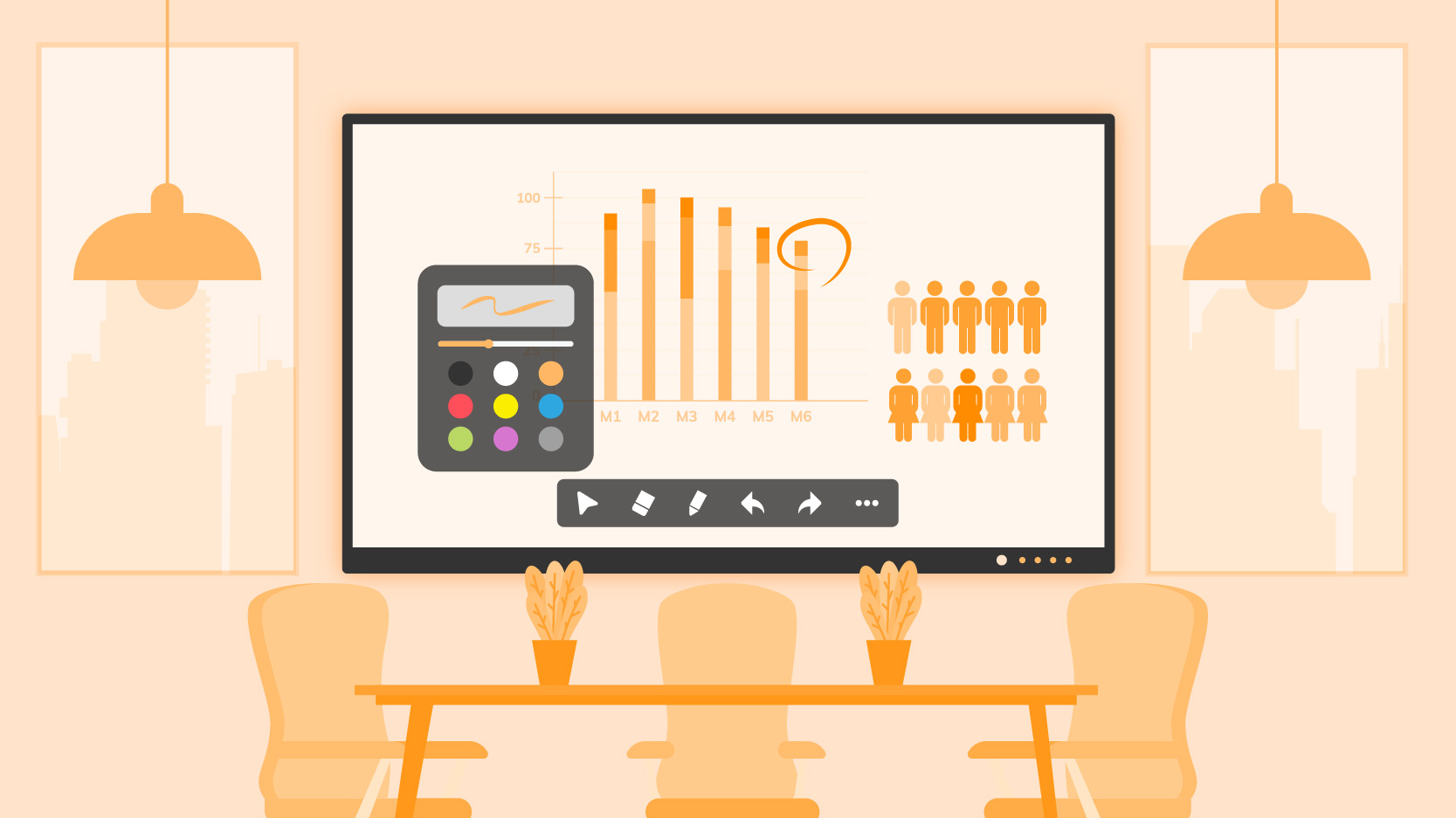
In today’s fast-moving business landscape, selecting the right smart board can have a profound effect on your team’s productivity, collaboration, and overall efficiency. These devices are now integral to modern offices, transforming meetings, presentations, and collaborative sessions into engaging, interactive experiences. Whether they’re known as interactive displays or interactive whiteboards, these tools provide the advanced functionality necessary to bring your office into the future. However, with so many options on the market, how do you ensure you’re selecting the right solution for your office?
In this blog, we’ll delve into the key considerations across four essential areas: hardware, software, operating system, and user experience. By focusing on these crucial aspects, you’ll be better positioned to choose a smart board that meets your office’s requirements, boosts collaboration, and enhances productivity, ultimately making your business more efficient and dynamic.
A smart board is an advanced interactive display that serves as a digital whiteboard, enabling users to write, draw, and interact with content directly on the screen. Featuring touch technology and integrated software, it enhances collaboration by supporting presentations, document editing, and real-time cloud access. Smart boards are designed to promote teamwork, streamline communication, and make meetings more productive, making them essential tools for modern businesses.
By 2025, the workplace will be increasingly dynamic, hybrid, and digitally driven. Smart boards will be pivotal in enabling:
Selecting the right smart board today will ensure your business stays ahead of the curve.
When selecting the ideal smart board for your office, it’s vital to assess several key factors that will determine how well the device meets your specific needs. From hardware specifications to software capabilities, every detail contributes to how effectively your interactive display or whiteboard can enhance productivity and foster collaboration within your workplace. Let’s explore these crucial considerations to help you make a well-informed decision.
The hardware of your smart board will directly influence its longevity, adaptability, and overall performance. Here’s what to consider:
For smart boards, particularly those with screen sizes of 55” and larger, 4K resolution should be considered the minimum benchmark. A 4K display offers four times the clarity of Full HD, ensuring that your presentations, charts, and graphics are sharp, vibrant, and easy to read, even in spacious meeting rooms. This level of resolution guarantees that everyone in the room can clearly view the content, reducing the risk of miscommunication and ensuring that every crucial detail is visible during important discussions.
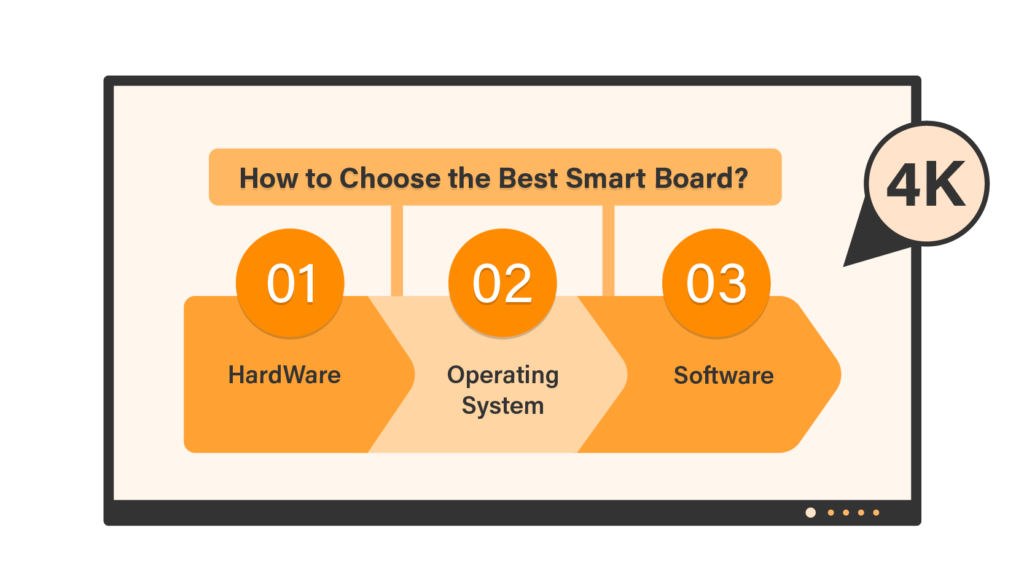
Selecting the correct screen size for your office smart board is essential in creating a comfortable and efficient meeting environment. A screen that’s too large for a small room can feel overwhelming, while one that’s too small for a spacious area may make it difficult for participants to see the details clearly. Here’s how to choose the right size for your meeting space:
Choosing the right screen size not only enhances visibility but also ensures that your meeting space feels appropriately balanced and functional, catering to both the size of the room and the number of participants.
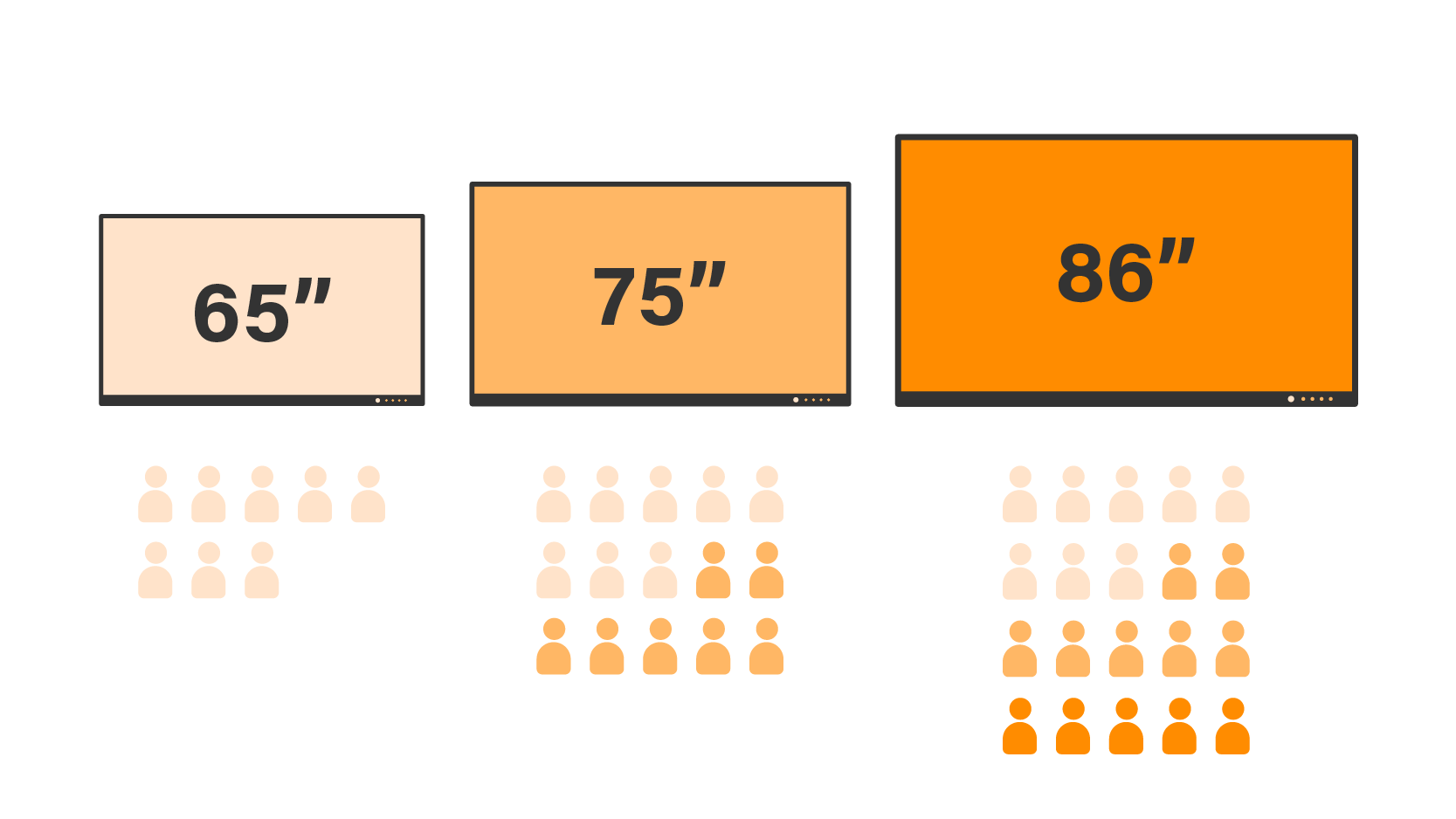
Connectivity options are critical in ensuring your smart board integrates smoothly with various devices and systems within your office. Key connectivity features to consider include:
WiFi connectivity is vital for smart boards, especially if you plan to use cloud-based applications or present wirelessly. WiFi 6, the latest standard, offers faster speeds, superior performance in crowded environments, and enhanced security. However, it’s important to consider your office’s security protocols—WiFi may be restricted in certain environments due to security concerns. In such cases, ensure your smart board is capable of operating effectively through wired connections or a secure local network.
If your office regularly engages in video conferencing, the quality and features of the webcam on your smart board are essential for a seamless experience. Look for integrated webcams that offer Full HD or 4K resolution, along with advanced features such as auto-framing or tracking. These capabilities ensure that remote participants can follow the conversation effortlessly, and that the speaker stays centred and in focus, even if they move around the room.
For offices that prioritise collaboration, a smart board with multi-touch functionality is crucial. Multi-touch technology allows multiple users to interact with the board at the same time, which is invaluable for brainstorming sessions, collaborative problem-solving, or dynamic presentations. Opting for a board with 40 touch points ensures a smoother and more engaging experience, especially in environments where several team members need to work together on the board simultaneously.
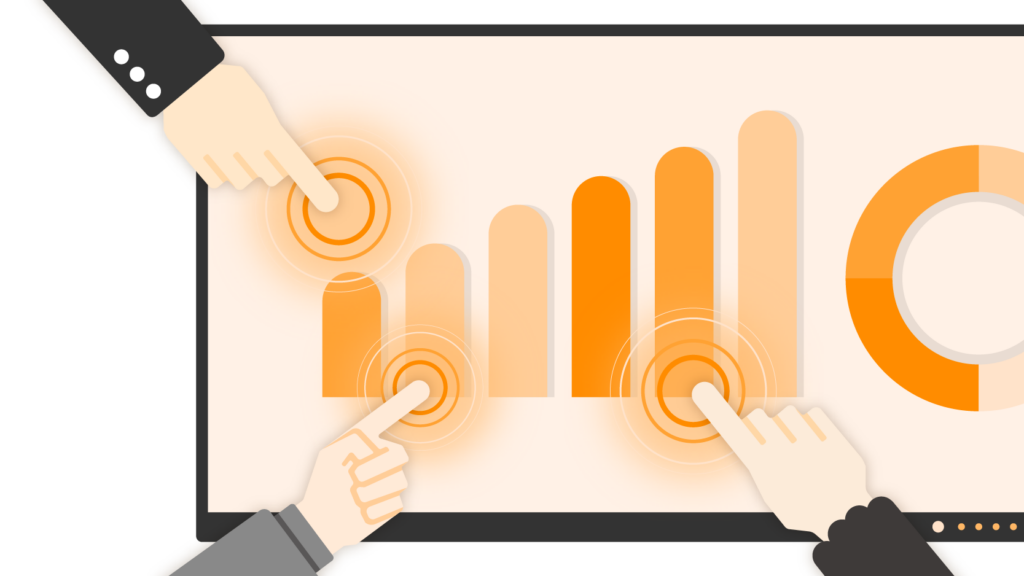
The operating system (OS) of your smart board plays a crucial role in its usability and compatibility with other tools and software used in your office. Consider the following key points when evaluating your options:
Choosing a smart board with an integrated Android operating system offers significant advantages, particularly in terms of its familiarity and ease of use. As the most widely used OS globally, Android provides a user-friendly interface that most users are already comfortable with, reducing the learning curve and ensuring immediate usability.
However, not all Android versions are the same. The latest version available for large smart boards is Android 13, which enhances performance, improves security features, and offers better support for modern productivity apps. By 2025, opting for a smart board with Android 13 or later will ensure you have access to the latest features and updates, making your meetings more efficient and your device more future-proof. Choosing a board with an older Android version could limit access to newer apps and features, potentially causing compatibility issues with the latest software.
For offices that work primarily in a Windows-based environment, the ability to switch between Android and Windows on your smart board can be incredibly beneficial. Many businesses rely on Windows-specific applications for daily tasks, such as project management software, data analysis tools, or industry-specific programmes. In such cases, a smart board with an expandable OPS (Open Pluggable Specification) slot is essential. This slot allows you to seamlessly integrate a Windows-based PC into your smart board, enabling you to run all your familiar Windows applications without disruption.
The dual system capability offers unmatched flexibility, allowing your team to easily switch between the Android OS for general tasks and the Windows OS for specialised needs. Whether you’re presenting a PowerPoint, running a complex Excel model, or using proprietary software, the ability to switch to a Windows environment ensures that your smart board can cater to all your business requirements.
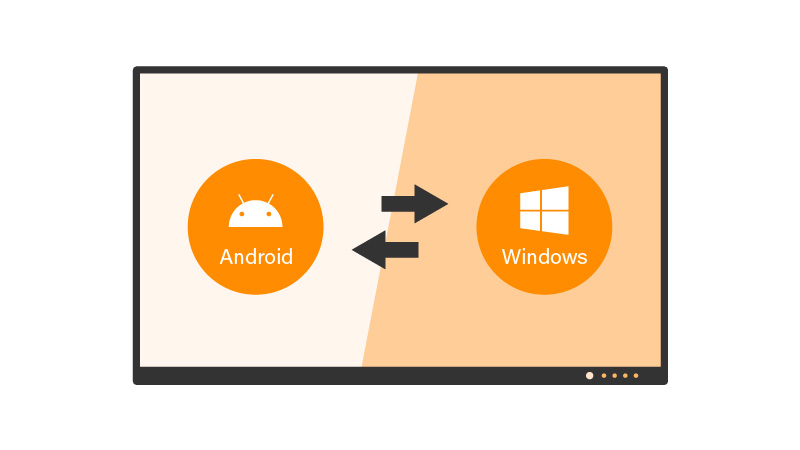
The storage capacity of your smart board is another important factor to consider. While 64GB may be sufficient for basic usage, offices that plan to store substantial amounts of data, applications, or multimedia content should opt for models with at least 128GB of storage. Adequate storage ensures that your smart board operates smoothly without lag or performance issues, even when handling large files or running multiple applications simultaneously. This will help maintain a seamless and efficient workflow throughout your meetings and collaborative sessions.
The software ecosystem of your smart board is key to unlocking its full potential. Here’s what to look for:
Google EDLA (Enterprise Devices Licensing Agreement) certification has become an essential standard for smart boards, particularly for offices that rely on Google Workspace. This certification ensures that the smart board integrates seamlessly with Google services, offering enhanced security, reliable performance, and access to a broad range of Google applications. With Google EDLA, your smart board becomes a personalised workspace, enabling users to access Gmail, Google Chrome, Google Drive, and other Google services directly from the board. This integration not only streamlines workflows but also boosts collaboration and productivity during meetings.
Why EDLA-Enabled Smart Boards Redefine Business Meetings lies in their ability to provide direct access to Google Play. This feature allows users to easily download productivity apps and video conferencing tools without the need for complicated workarounds. Unlike older smart boards, which often required manual APK installations that could lead to compatibility issues, EDLA-certified boards simplify the process, ensuring that your smart board is always equipped with the latest tools for effective, efficient meetings.
Wireless presentation apps are vital for modern meeting environments, particularly where BYOD (Bring Your Own Device) policies are in place. Look for a smart board that supports popular wireless presentation platforms like AirPlay, Miracast, and Google Cast. These apps enable team members to share their screens wirelessly, regardless of the device they’re using. This flexibility makes it easier for everyone to participate, whether they’re using a PC, Mac, tablet, or smartphone. Wireless presentation capabilities eliminate the need for cumbersome cables and adapters, speeding up the meeting setup and reducing the likelihood of technical issues.
For many businesses, Microsoft Office remains a cornerstone of daily operations. Ensure your smart board is compatible with Microsoft Office apps, enabling users to edit and view Word, Excel, PowerPoint, and other Office documents directly on the board. This compatibility ensures that your team can continue working seamlessly without needing to convert files or switch between devices. Having native support for Microsoft Office means that employees can open, edit, and share documents directly on the board without delays, making meetings more efficient and reducing technical disruptions.
An interactive whiteboard app is a must-have feature for any smart board, promoting real-time collaboration and brainstorming. This feature goes beyond simply writing or drawing—it serves as a hub for creativity and problem-solving that can bring your team’s ideas to life. Here’s what to look for:
Here are some real-world examples of how smart boards can revolutionise your office by 2025:
Smart boards with AI-powered tools can elevate brainstorming sessions into dynamic, interactive experiences. Teams can sketch ideas, convert handwritten notes into text, and instantly share results with remote participants, regardless of their location. This enables faster idea generation and smoother collaboration, making these sessions more productive and inclusive.
Leverage smart boards to create engaging and immersive training sessions. With augmented reality (AR) overlays and 3D modelling, new hires can interact with complex concepts in an engaging, hands-on way. This approach enhances understanding, making onboarding quicker and more effective, while ensuring that your team gets up to speed faster.
Smart boards can integrate with data analytics tools, displaying real-time dashboards that help teams make faster, data-driven decisions during meetings. Visualising data on a large, interactive screen ensures everyone is on the same page, enabling more informed discussions and quicker decision-making processes.
With advanced video conferencing and virtual whiteboarding, smart boards bridge the gap between in-office and remote teams. This ensures that remote participants feel just as involved as those present in the room, promoting seamless collaboration and enhancing team engagement, no matter where everyone is located.
Choosing the best smart board for your office in 2025 requires focusing on cutting-edge hardware, AI-driven software, hybrid work capabilities, and long-term flexibility. By investing in a solution that aligns with these trends, you’ll empower your team to collaborate more effectively, innovate faster, and remain competitive in an increasingly dynamic market.
Don’t wait until 2025 to upgrade your workspace. Contact us today to explore smart board solutions designed for the future of work. Let’s build a smarter, more collaborative tomorrow—together.


